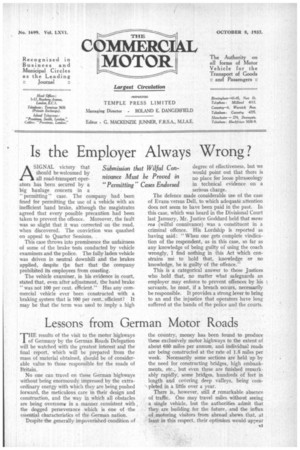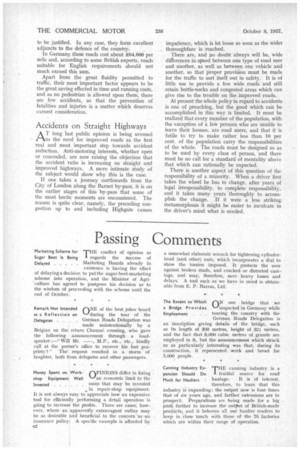Lessons from German Motor Roads
Page 35

Page 36

If you've noticed an error in this article please click here to report it so we can fix it.
THE results of the visit to the motor highways of Germany by the German Roads Delegation will be watched with the greatest interest and the final report, which will be prepared from the mass of material obtained, should be of considerable value to those responsible for the roads of Britain.
No one can travel on these German highways without being enormously impressed by the extraordinary energy with which they are being pushed forward, the meticulous care in their design and construction, and the way in which all obstacles are being overcome in a manner consistent with, the dogged perseverance which is •one of the essential characteristics of the German nation.
Despite the generally impoverished condition of the country, money has been found to produce these exclusively motor highways to the extent of about 650 miles per annum, and individual roads are being constructed at the rate of 1.5 miles per week. Necessarily some sections are held up by the need for constructing bridges, high embankments, etc., but even these are finished remarkably rapidly, some bridges, hundreds of feet in length and covering deep valleys, being completed in a little over a year.
There is, however, still g remarkable absence of traffic. One may travel miles without seeing a single vehicle, but the authorities admit that they, are building for the future, and the influx of motoring visitors from abroad shows that, at least in this respect, their optimism would appear to be justified. In any case, they form excellent adjuncts to the defence of the country.
In Germany these roads cost about £64,000 per mile and, according to some British experts, roads suitable for English requirements should not much exceed this sum.
Apart from the great fluidity permitted to traffic, their most important factor appears to be the great saving effected in time and running costs, and as no pedestrian is allowed upon them, there are few accidents, so that the prevention of fatalities and injuries is a matter which deserves earnest consideration.
Accidents on Straight Highways
AT long last public opinion is being aroused to the need for improved roads as the first real and most important step towards accident reduction. Anti-motoring interests, whether open or concealed, are now raising the objection that the accident ratio is increasing on straight and improved highways. A more intimate study of the subject would show why this is the case.
If one takes a journey northwards from the City of London along the Barnet by-pass, it is on the earlier stages of this by-pass that some of the most hectic moments are encountered. The reason is quite clear, namely, the preceding congestion up to and including Highgate causes impatience, which is let loose so soon as the wider thoroughfare is reached. There are, and no doubt always will be, wide differences in speed between one type of road user and another, as well as between one vehicle and another, so that proper provision must be made for the traffic to sort itself out in safety. It is of little use to provide a few wide roads and still retain bottle-necks and congested areas which can give rise to the trouble on the improved roads.
At present the whole policy in regard to accidents is one of preaching, but the good which can be accomplished in this way is limited. It must be realized that every member of the population, with the exception of a few persons who are unable to leave their houses, are road users, and that it is futile to try to make rather less than 10 per cent. of the population carry the responsibilities of the whole. The roads must be designed so as to be used by every class of person, and there must be no call for a standard of mentality above that which can rationally be expected.
There is another aspect of this question of the responsibility of a minority. When a driver first takes the wheel he has to change, after years of legal irresponsibility, to complete responsibility, and it takes many years thoroughly to accomplish the change. If it were a less striking metamorphosis it might be easier to inculcate in the driver's mind what is needed.




























































































